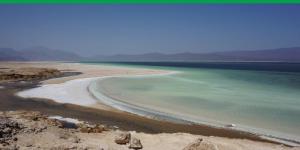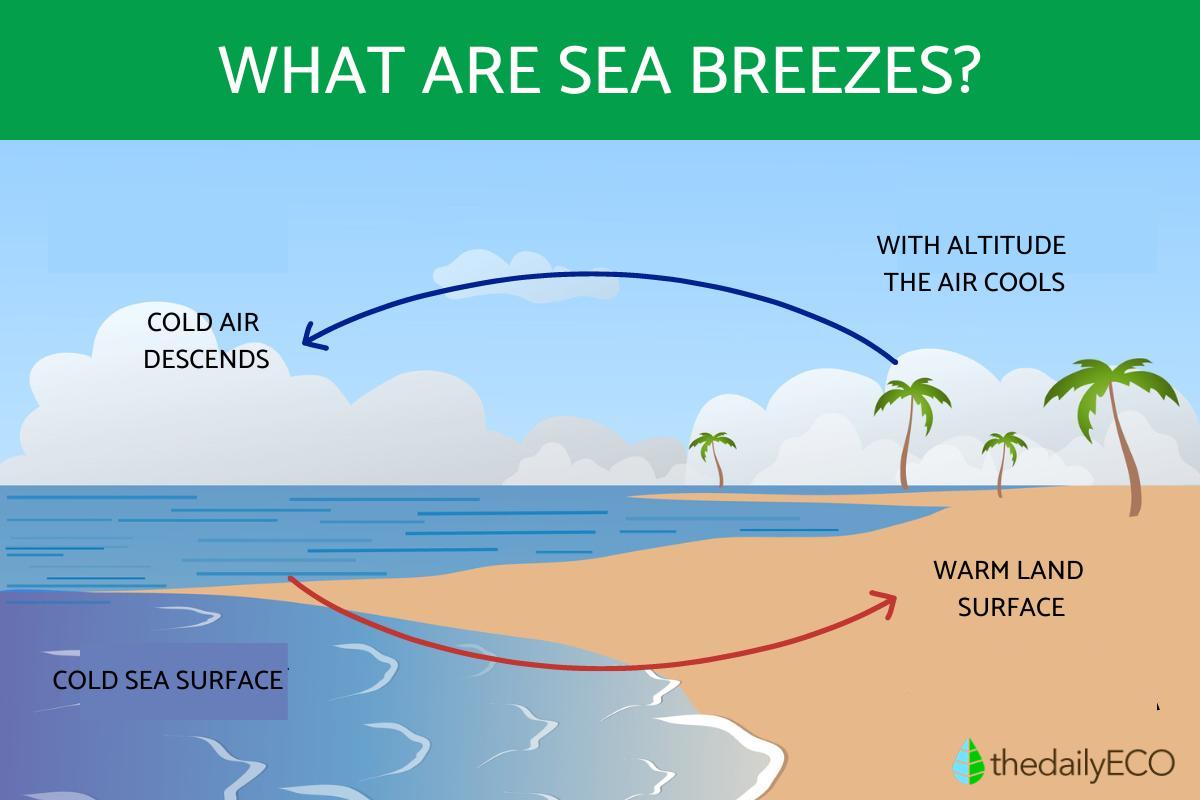What Is a Sea Breeze?


Have you ever noticed how, on a hot summer day at the beach, the air suddenly becomes cooler and fresher when a gentle breeze blows in from the sea? This refreshing breeze is called a sea breeze and is a fascinating meteorological phenomenon that occurs in many coastal regions of the world. Ocean breezes are important for regulating temperature, improving air quality, and supporting marine ecosystems, among other things.
The following thedailyECO article will explores what sea breezes are, how they form, and why they are important.
What are sea breezes?
Sea breezes are local winds that occur in coastal areas due to temperature differences between land and sea. During the day, the land surface warms faster than the sea surface, making the air over the land warmer and less dense than the air over the sea. As a result, the warm air rises and cooler air from the sea flows in to replace it, creating a sea breeze.
They are most pronounced on clear, sunny days when the temperature difference between land and sea is greatest.
In some cases, sea breezes can also produce thunderstorms, as rising warm air over land can create instability in the atmosphere and trigger convective activity.
Ocean breezes can have important impacts on local weather and climate, as they can help moderate temperatures in coastal areas and alleviate hot, humid conditions. They can also have significant ecological impacts, as they can influence the distribution of marine and terrestrial organisms in coastal ecosystems.
How do sea breezes form?
Sea breezes, as mentioned earlier, are an atmospheric phenomenon caused by the difference in temperature between the surface of the earth and the surface of the sea. Described below are the steps involved in the formation of a sea breeze:
- During the day, the sun heats the land and the sea. However, the land heats up faster than the sea.
- As the land heats up, the air above it becomes warmer and less dense. This warm air rises and creates a low pressure area over the land.
- The rising warm air creates a vacuum that is filled by cooler, denser air over the ocean. This air moves toward land and replaces the rising warm air.
- As the cooler ocean air moves inland, it is deflected upward by the rising warm air over the land. This creates an onshore breeze that is perceived as a cool wind near the coast.
- The sea breeze continues until the temperature difference between land and sea is equalized or reversed. This usually happens in the late afternoon or early evening when the land has cooled down.
- At night, the reverse process takes place. The land cools faster than the sea, causing the cool air over the land to sink and creating an area of high pressure over the land.
- The sinking cool air creates a vacuum that is filled by warmer, less dense air over the sea. This air moves toward land and replaces the sinking cool air.
- As the warmer air from the sea moves toward land, it is deflected upward by the cooler air over the land. This creates an offshore breeze that is perceived as a cool wind blowing away from the coast.
This pattern of sea and land breezes continues in a daily cycle, with the sea breeze during the day and the land breeze at night.

Conditions for the formation of sea breezes
Sea breezes require certain conditions to form. Below are some of the most important conditions that contribute to the formation of sea breezes:
- Differential warming: for a sea breeze to form, there must be a difference in temperature between the land and the sea.
- Land-Sea Orientation: for a sea breeze to develop, the wind direction should be perpendicular to the coastline so that the sea breeze can penetrate inland.
- Smooth coastline: a smooth coastline with little difference in terrain is ideal for a sea breeze to develop because it allows the breeze to penetrate inland without being disturbed by hills, mountains, or other topographic features.
- Sunny skies: On clear, sunny days, the sea breeze tends to be stronger and more persistent as the sun heats up the land more quickly.
- Strong sun angle: The angle of the sun is also important. Sea breezes tend to be stronger when the sun is high in the sky because the angle of the sun's rays is more perpendicular to the surface of the land and sea.
- Light winds in the air: light winds at high altitudes can favor the development of a sea breeze. If the winds at higher altitudes are light or calm, the sea breeze can penetrate further inland and be more persistent.
You may be interested in this other article, where we explain how mountains are formed.
Importance of sea breezes
Sea breezes are indeed important, especially in coastal regions where they occur. Sea breezes can help regulate temperatures in coastal areas and provide a refreshing change from hot summer temperatures. The cool breezes can help reduce heat stress for people, animals, and plants, and they can also help cool buildings and infrastructure.
Ocean breezes can also improve air quality in coastal regions. Onshore breezes can bring in fresher, cleaner air from the ocean and help dilute and disperse pollutants and particulate matter that can accumulate in urban areas.
Furthermore, sea breezes can impact marine ecosystems by causing upwelling of nutrient-rich water near the coast. When onshore breezes push surface water toward the coast, deeper, colder water is brought to the surface, providing nutrients for plankton and other marine organisms.
Moreover, ocean breezes can also be harnessed to produce power, particularly wind power. The consistent, predictable nature of ocean breezes makes them an attractive source of renewable energy for coastal communities.
Finally, ocean breezes can promote coastal recreational activities such as sailing, kiteboarding, and other water sports. The cool breeze can make these activities more comfortable and enjoyable, while providing a natural and sustainable source of energy for sailing and other activities.
You may be interested in this other article, where we explain what sea ice is and how it forms.
Other characteristics of sea breezes
Let's examine some of the most interesting features of sea breezes now that we understand what they are and how they form:
- The sea breeze moves by copying the relief of the terrain, so it can take different directions depending on the orography and morphology.
- The speed of the sea breeze depends on the temperature difference between the two air masses. The greater this difference, the higher the speed.
- The movement of the sea breeze is also influenced by a more far-reaching phenomenon, the Coriolis force. The Coriolis force is an inertial force that acts on objects in motion relative to a rotating reference frame, such as the surface of the Earth.
- The spatial extent of sea breezes is not limited to the coast, but can travel up to hundreds of kilometers from the coast.
- In the islands, they are usually multidirectional, that is, they come simultaneously from the different coasts and penetrate into the interior of the land area, which can occasionally lead to convective summer storms.
You may be interested in this other article, where we explain what is the difference between lagoons and lakes.
If you want to read similar articles to What Is a Sea Breeze?, we recommend you visit our Facts about nature category.
- Alomar Garau G. 2013. Sea breezes and their geographical significance . Available at: https://dialnet.unirioja.es/servlet/articulo?codigo=4568417
- Montoro P. 2020. Virtual laboratory: How is the sea breeze formed? Available at: https://www.youtube.com/watch?v=paloA2GLUcs






